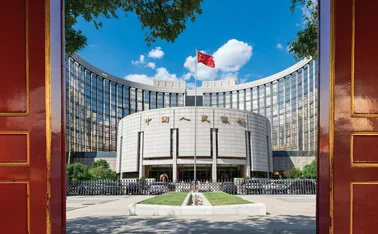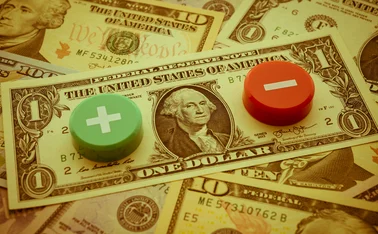
Banknote and currency services provider of the year: Leonhard Kurz Stiftung & Co
German company leading the way in banknote foil security innovation

Central banks are responsible for an estimated 375 billion banknotes in circulation around the world, according to security providers. The integrity of which ensures the functioning of modern societies. They are challenged in fulfilling this role by ever-more sophisticated counterfeiting groups. To combat this threat, central banks need to get their banknote security right, and an essential element in achieving this aim lies in having innovative and reliable partners.
Leonhard Kurz Stiftung & Co – a company that has worked on more than nine new banknote denominations in seven different countries in the past year – has emerged as a partner of choice for many leading central banks. The foil pioneer is viewed as a leading supplier of secure diffractive optically variable devices (OVDs) and has incorporated security foils into banknote designs in more than 80 countries around the world.
Not so easily foiled
Collaboration and co-operation are viewed as vital by Kurz. And the German company is capable of exceeding expectations when it comes to addressing customer demands. Take the Bank of Israel. The Israeli central bank eschews shiny foils on its banknotes as it believes they offer a sense of false confidence to the public. "Shiny foils are likely to be considered as genuine by the general public without any thorough checks," explains Lior Lichtman, head of the issuance division currency department at the Bank of Israel.
As a result, Lichtman and his team asked Kurz if it could alter its foil design. "When we first broached the idea to Kurz it was a bit difficult for them to understand and accept," Lichtman says. "But once they visited us in Jerusalem to properly pitch the idea, we got them on board."
This led to Kurz building on the first developments of 'kinegram volume', a "completely different animal to other foils we have produced", says Peter Muehlfelder, managing director, OVD Kinegram, which supports the technological advancement of banknote security elements. What makes this security feature novel is the visual 'on-off' effect for the spectator; the visibility of the images are only given at pre-defined angles, which means they are extremely hard to recreate.
The new 50 shekel note, launched in September 2014, included this feature and represented a broader collaborative effort between the Bank of Israel and Kurz, which worked alongside other suppliers throughout the project.
Kurz's willingness to co-operate and communicate with the other members of the supply chain was a key factor in the Bank of Israel maintaining an excellent relationship with the company during the past 15 years. "If ever there was a problem with the foil application they would send people over to fix it. Not once did they pardon off the issue to another party," Lichtman says. "We are very happy and proud of the relationship we have formed with Kurz over the years. They make a conscious effort to maintain that relationship."
Brian Hayr, head of currency, property and security at Reserve Bank of New Zealand (RBNZ), also expressed how pleased he was with Kurz's collaboration on the country's new 'brighter money' series. "It is rare to get everybody from all points in the supply chain together in a room," says Hayr, "Kurz was very supportive in that process."
Leading-edge R&D
Since 2013, Kurz has worked with the RBNZ on the development of its latest banknote series, which underwent a 'soft launch' in September 2015. The first two denominations, the NZ$5 and NZ$10 notes, were the first in the world to feature distinct high-security foil patches on polymer banknotes. These patches, the result of kinegram zero.zero technology, were applied over a transparent polymer window.
 New Zealand banknotes
New Zealand banknotes
The company's R&D experts and application engineers worked to develop an original foil formulation that would fulfil the optical and durability requirements stipulated by RBNZ, combined with a patch application process relevant for the polymer banknote substrate used for New Zealand banknotes. "They put in substantial effort in the research and development, above what we would have expected. And actually designing the foil itself, there was a lot of extra work put into that," Hayr says. "But that didn't deter Kurz from getting the product out within tight timelines. That was where they really stood out for us. They threw a lot of resources at it and worked with our team very well."
Kurz has a legacy of investing in research and development, constantly striving to be the best in its field. When foils were a relatively new venture two decades ago, the Central Bank of Hungary was one of the first banks to adopt the technology. "Kurz is not just a simple security device provider. Since the very beginning they were also technology suppliers and consultants as well. They supported our new series development with external R&D activity and by providing trial production possibilities," says Tibor Pataki, head of directorate cash logistics at the Hungarian central bank, whose latest 10,000 forint banknotes were issued in December 2014. Its 20,000 forint notes were released on December 14, 2015, using Kurz technology.
The 'kinegram review' is one of the latest features to emerge from the Kurz R&D centre. Here, Kurz has combined banknote windows with foil security whereby the foil operates different diffractive images; images seen from the front of the note are fundamentally different from those seen on the reverse. This feature was launched on the new €20 note and was first highlighted by European Central Bank president Mario Draghi in February 2015: "The portrait window is a real innovation in banknote technology... to ensure the euro notes continue to be resilient against counterfeiting," Draghi said.
And Kurz does not plan to stand still. Next year 'kinegram colors' will enter the market for the first time. The technology stands out from monochromatic foil as the 'foil' seen from the front of the banknotes is available in one-, bi- or multi-colour options. It can also be adapted to laminate foil for window banknotes with further colour options. "A large, important central bank has selected kinegram colors technology to be used on their future series of banknotes, which is currently under development," Muehlfelder says.
The feature will be introduced at a time of important technological advancements in the industry, with several central banks issuing new banknotes or banknote series in 2016, including the Bank of England and the Swiss National Bank.
Watch our interview with Peter Muehlfelder, head of business area security at Kurz
The Central Banking awards were written by Christopher Jeffery, Tristan Carlyle, Daniel Hinge, Arvid Ahlund, Dan Hardie and Rachael King.
Only users who have a paid subscription or are part of a corporate subscription are able to print or copy content.
To access these options, along with all other subscription benefits, please contact info@centralbanking.com or view our subscription options here: http://subscriptions.centralbanking.com/subscribe
You are currently unable to print this content. Please contact info@centralbanking.com to find out more.
You are currently unable to copy this content. Please contact info@centralbanking.com to find out more.
Copyright Infopro Digital Limited. All rights reserved.
As outlined in our terms and conditions, https://www.infopro-digital.com/terms-and-conditions/subscriptions/ (point 2.4), printing is limited to a single copy.
If you would like to purchase additional rights please email info@centralbanking.com
Copyright Infopro Digital Limited. All rights reserved.
You may share this content using our article tools. As outlined in our terms and conditions, https://www.infopro-digital.com/terms-and-conditions/subscriptions/ (clause 2.4), an Authorised User may only make one copy of the materials for their own personal use. You must also comply with the restrictions in clause 2.5.
If you would like to purchase additional rights please email info@centralbanking.com








